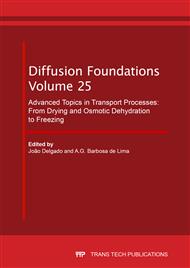[1]
Information on http://www.fao.org/corp/statistics/en/, FAO. Food and Agriculture Organization of the United Nations, Accessed on: 18 January. (2017).
Google Scholar
[2]
A. K. Pleti, J. J. Lima, J. J.,L. M. B Cândido, Internal quality of the ostrich egg after storage at room temperature and refrigerated, Rural Science, 39 (6), 1864-1868, 2009. (In Portuguese).
Google Scholar
[3]
M. Martins, Information on http://www.bandad.com.br/,ariana-martins1/fala-serio/beneficios-do-ovo0de-pata, Accessed on: 18 January. 2017. (In Portuguese).
Google Scholar
[4]
A. C. Awade, S. Moreau, D. Molle, G. Brulé, J. L. Two-step chromatographic procedure for the purification of hen egg white ovomucin, lysozyme, egg transferring and egg's albumin and characterization of purified proteins,J. Cromatogr. A, 677 (3) (1994) ,279-288.
DOI: 10.1016/0021-9673(94)80156-8
Google Scholar
[5]
G. Linden, D. Lorient, Agroindustrial Biochemistry. Food revaluation of agricultural production, 1 Ed, Zaragoza: Acribia, (1996.), 43-163. (In Spanish).
Google Scholar
[6]
Muller, H. G.; Tobin, G. Nutrition and Food Science, Acribia., Zaragoza (1996).
Google Scholar
[7]
A. V. Madrid, J. Cenzano, J. M. Vicente, Guide of food industry. São Paulo: Varela, (1996), 489-495. (In Portuguese).
Google Scholar
[8]
P. Bobbio, F. Bobbio, Introduction to food chemical, second ed. São Paulo: Varela. pp.127-132. 1992. (In Portuguese).
Google Scholar
[9]
R. M. Griswold, Experimental study of food, Edgard Blügher,Rio de Janeiro, 1972. (In Portuguese).
Google Scholar
[10]
O. R. Fennema, Food Chemical, Acribia, Zaragoza, pp.931-959, 1993. (In Spanish).
Google Scholar
[11]
K. Lomakina, K. A. Míková, Study of the factors affecting the foaming properties of egg white – a review., Czech J. Food Sci.,24 (3) (2006), 110-118.
DOI: 10.17221/3305-cjfs
Google Scholar
[12]
J. G. Brennan,Food Dehydration: a dictionary and guide, Buttenvorth-Heinemann, Oxford, 189p.,(1994).
Google Scholar
[13]
P.Fellows,Food Processing Technology. Principles and Practice, seconded., CRC Press,NewYork, 562p. (2000).
Google Scholar
[14]
F. J. Francis,Encyclopedia of Food Science and Technology,second ed. New York: John Wiley e Sons, v.12907, n. 1, (2000).
Google Scholar
[15]
E. T. Andrade, P. C. Correa, L. P. Teixeira, R. G, Pereira,J. F. Calomeni,Drying kinetic and quality of bean reeds, Engevista, 8(2) (2006), 83-95. (In Portuguese).
Google Scholar
[16]
D. MKadam, R. T.Patil,P.Kaushik,Foam-mat Drying of Vegetables and Fruits products. In Drying Foods, Vegetables and Fruits, 35 (4) (2010), 488-495. (Publish in Singapore).
Google Scholar
[17]
W. J. Stadelman, O. J. Cotterill, Egg Science and Technology,fourth ed,Haworth Food Products, New York, (1995).
Google Scholar
[18]
M. Mapa, Regulation of industrial and sanitary inspection of animal origin product, (2005).
Google Scholar
[19]
A. A. Karim,C. C. Wai, Characteristics of foam prepared from starfruit (Averrhoa carambola L.) puree by using methyl cellulose, Food Technology Division, School ofIndustrial Technology, University Saints Malaysia, Penang, Malaysia, [s/vol.], [s/p.], (1999).
DOI: 10.1016/s0268-005x(98)00086-1
Google Scholar
[20]
Lutz, A. Physic – Chemical method for food analysis, fourth ed., 2008. (In Portuguese).
Google Scholar
[21]
S.K. Park, S.R. Shanbhag, A.E. Dubin, M. Bruyne, Q. Wang, P. Yu, N. Shimoni, S. D'Mello, J.R. Carlson, G.L. Harris, R.A. Steinbrecht., C.W. Pikielny, Inactivation of olfactory sensilla of a single morphological type differentially effects the response of Drosophilatoodors., J. Neurobiol, 51 (3) (2002), 248-260.
DOI: 10.1002/neu.10057
Google Scholar
[22]
A. Midilli, H. Kucuk, Z. A. Yapar, New model for single-layerdrying, Drying Technology, 20 (2002), 1503-1513.
DOI: 10.1081/drt-120005864
Google Scholar
[23]
Q. Zhang, J.B. Litchfield, An optimization of intermittent corn drying in a laboratory scale thin layer dryer, Drying Technology, 9 (1991), .383-395.
DOI: 10.1080/07373939108916672
Google Scholar
[24]
E. R. Mangueira, Study of duck egg (foam mat drying), Master dissertation, in Chemical Engineer - Federal University of Paraíba, João Pessoa, 2017. (In Portuguese).
Google Scholar
[25]
Q.Lui, M. D. Martins, F. W Bakker, Arkema Stochastic modelling of grain drying: Part 1: Experimental Investigation, Journal of Agricultural Engineering Research, 66 (. 4) (1997), 267-273.
DOI: 10.1006/jaer.1996.0146
Google Scholar
[26]
L.K. Davis, J. Xiao, A. Hsouna, T. Hsu, J. M. O'donnell, The Catecholaminesignalongpathway in Trachealdevelopment in Drosophila melanogaster, A. Dros. Res. Conf. 45 ,643A2004.
Google Scholar
[27]
T. Kudra, C. Ratti. C. Foam-mat drying: energy and cost analyses. Canadian Byosystems Engineering, 48 (2008), 327-332.
Google Scholar
[28]
K. O. Falade, K. I. Adeyanju, P. I. Uzo-Petters, Foam-mat drying of cowpea (Vigna unguiculata) using glyceryl monostearate and egg albumin as foaming agents,European Food Research and Technology, 217 (2003), 486-491.
DOI: 10.1007/s00217-003-0775-3
Google Scholar
[29]
T. S.Pereira,Foam-mat drying study of white egg. Master dissertation in Agri-industrials systems, Federal University of Campina Grande,Pombal, 2015. (In Portuguese).
Google Scholar
[30]
E. Marinova, J. M. A. Van DerValk, S.M. Valamoti, J. Bretschneider, Experimental Approach for Tracing Olive Processing Residues in the Archaeobotanical Record with Preliminary Examples from Tell Tweini, Syria,Vegetation History and Archaeobotany, 20 (2011),471-478.
DOI: 10.1007/s00334-011-0298-y
Google Scholar
[31]
S. C.M. Dantas, Dehydration of fruit pulp by the foam-mat method, Master dissertation in Chemical Engineering, Federal University of the Rio Grande do Norte. Natal, Brazil, 2010. (In Portuguese).
Google Scholar
[32]
M. G. Campbell, E. Mougeot, Creation and characterization of aerated food products, Trends in Food Science & Technology, 10 (1999), 283 -296.
DOI: 10.1016/s0924-2244(00)00008-x
Google Scholar
[33]
D. M. Kadam, S. Balasubramanian, Foam mat drying of tomato juice, Journal of Food Processing and Preservation, 35 (4) (2010), 488-495.
DOI: 10.1111/j.1745-4549.2010.00492.x
Google Scholar
[34]
N. Kampf, M. C Gonzalez, M. G. Corradini, M. Peleg, Effect of two gums on the development, rhelogical properties and stability of egg albumen foams. Rheologica Acta, 42(2003), 259-268.
DOI: 10.1007/s00397-002-0281-8
Google Scholar
[35]
H.D. Belitz, W. Grosch, P. Schieberle, Food Chemistry, fourth revised and extended ed., Springer-Verlag.1070p, 2009. til, R.T., andKaushik, P. (2010 a). Foammatdryingoffruitandvegetable products. In Dryingoffoods, vegetablesandfruits - Volume 1 (S.V. Jangam, C.L. Law and A.S. Mujumdar, eds) pp.113-124.
Google Scholar


